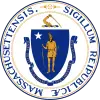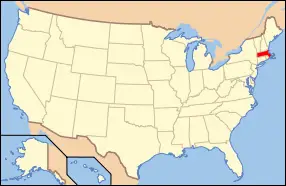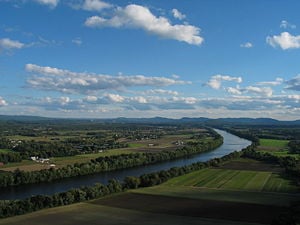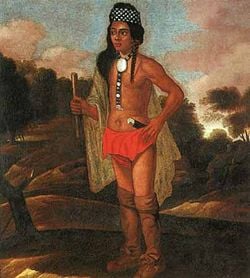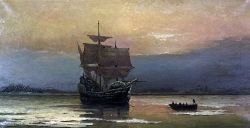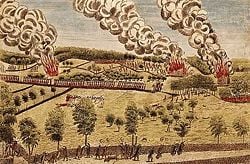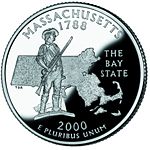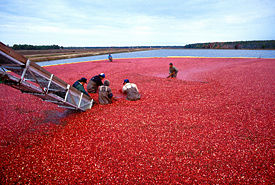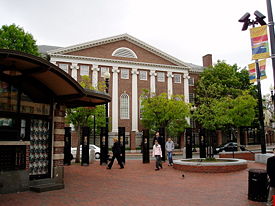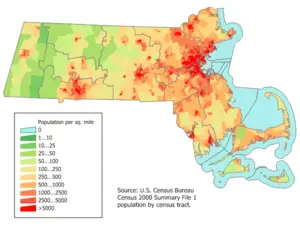Massachusetts
| Commonwealth of Massachusetts | |||||||||||
| |||||||||||
| Official language(s) | None | ||||||||||
| Capital | Boston | ||||||||||
| Largest city | capital | ||||||||||
| Largest metro area | Greater Boston | ||||||||||
| Area | Ranked 44th | ||||||||||
|  - Total | 10,555[1] sq mi (27,336 km²) | ||||||||||
|  - Width | 183 miles (295 km) | ||||||||||
|  - Length | 113 miles (182 km) | ||||||||||
| Â -Â % water | 25.7 | ||||||||||
|  - Latitude | 41°â14ⲠN to 42°â53ⲠN | ||||||||||
|  - Longitude | 69°â56ⲠW to 73°â30ⲠW | ||||||||||
| Population | Ranked 14th in the U.S. | ||||||||||
| Â -Â Total | 6,587,536 (2011 est)[2] | ||||||||||
| - Density | 840/sq mi (324/km2) Ranked 3rd in the U.S. | ||||||||||
|  - Median income | $65,401 (2008) (6th) | ||||||||||
| Elevation | Â | ||||||||||
|  - Highest point | Mount Greylock[3][4] 3,489 ft (1063.4 m) | ||||||||||
|  - Mean | 500 ft (150 m) | ||||||||||
|  - Lowest point | Atlantic Ocean[3] 0 ft (0 m) | ||||||||||
| Admission to Union | February 6, 1788 (6th) | ||||||||||
| Governor | Deval Patrick (D) | ||||||||||
| Lieutenant Governor | Tim Murray (D) | ||||||||||
| U.S. Senators | John Kerry (D) Scott Brown (R) | ||||||||||
| Time zone | Eastern: UTC-5/-4 | ||||||||||
| Abbreviations | MA Mass. US-MA | ||||||||||
| Web site | http://www.mass.gov/ | ||||||||||
The Commonwealth of Massachusetts is a state in the New England region of the Northeastern United States. Most of its population of 6.4 million live in the Boston metropolitan area. Massachusetts is the most populous of the six New England states, having the top two most populated cities (Boston and Worcester) and ranks third in overall population density among the 50 states.
The first Europeans to settle New England landed in present-day Massachusetts. These settlers were primarily non-conformists (later called Pilgrims) and Puritans from England seeking religious freedom. They founded Plymouth, Salem, and Boston, which soon became the hub of the region, then the Pioneer Valley along the Connecticut River where the state's best agricultural land was concentrated. A century and a half later, Massachusetts became known as the 'Cradle of Liberty' for the revolutionary ferment in Boston that helped spawn the war of the Thirteen Colonies for independence.
Massachusetts has been a significant state in American history. The first battles of the American Revolution were fought in the Massachusetts towns of Concord and Lexington in 1775. The Boston Tea Party is an example of the protest spirit of the pre-revolutionary period. In the nineteenth century, the state became a bastion of social progressivism and a birthplace of the abolitionist movement that emancipated southern blacks from slavery.
Name
The Massachusetts Bay Colony was named after the indigenous population, known as the Massachusett, part of the Wampanoag of the Algonquian peoples.[5] The Massachusett were almost totally wiped out by a European-introduced plague between 1616 and 1619, and the remaining population was scattered in the wake of a massacre of Massachusett warriors led by Captain Miles Standish of Plymouth Colony in 1623.
The term "Massachusetts" has been translated as "at the great hill," "at the little big hill," or "at the range of hills," referring to the Blue Hills, or in particular, Great Blue Hill, to the southwest of Boston.
There have been various intrepretations of the name, mainly via French or English interpretations of local Indian tribal languages. Commonly accepted is the definition of "massa" meaning "great" and "wachusett," "mountain-place."
Geography
Massachusetts is bordered on the north by New Hampshire and Vermont; on the west by New York; on the south by Connecticut and Rhode Island; and on the east by the Atlantic Ocean. Elevations increase towards the north and west and the highest point in the state is Mount Greylock at 3,491 feet near the state's northwest corner.
The uplands, which range includes New Hampshire, Vermont, Rhode Island, and eastern New York are interrupted by the downfaulted Pioneer Valley along the Connecticut River, the largest river that flows through the state, and further west by the Housatonic Valley separating the Berkshire Hills from the Taconic Range along the western border with New York. The Berkshire Hills are also commonly referred to as the Berkshire Massif.
The remainder of the state west of Pioneer Valley is mainly uplands, a range of small mountains known as the Berkshires, which largely remained in aboriginal hands until the 18th century when Scotch-Irish settlers arrived and found the more productive lands already settled, so they chose to work in the mines and furnaces. Availability of better land in western New York and the Northwest Territories soon put the upland agricultural population into decline. Available water power lead to 19th century settlement along upland rivers. The villages of Pittsfield and North Adams grew into small cities, with a number of smaller mill towns along the Westfield River.
Climate
Massachusetts has a humid continental climate, with warm summers and cold, snowy winters. It receives about 40 inches of rain annually, fairly evenly distributed throughout the year, slightly wetter during the winter. Summers are warm with average high temperatures in July above 80°F and overnight lows above 60° common throughout the state. Winters are cold, but generally less extreme on the coast with high temperatures in the winter averaging above freezing even in January, although areas further inland are much colder. The entire state has cold winters and moderately warm summers, but the Berkshires in the west have both the coldest winters and the coolest summers. The state does have extreme temperatures from time to time with 90°F in the summer and below 0°F temperatures in the winter not being unusual. The record high temperature in the state is 107°F (42°C), established at Chester and New Bedford on August 2, 1975; the record low is â35°F (â37°C), registered at Chester on January 12, 1981.
The state has its share of extreme weather, prone to Nor'easters and to severe winter storms. Summers can bring thunderstorms, averaging around 30 days of thunderstorm activity per year. Massachusetts lies in the âprevailing westerlies,â the belt of generally eastward air movement, which encircles the globe in the mid-latitudes. Embedded in this circulation are extensive masses of air originating in more northerly or southerly latitudes and interacting to produce frequent significant storm systems. Relative to most other sections of the country, a large number of such storms pass over or near to Massachusetts.
The majority of air masses affecting the state belong to three types:
- cold, dry air pouring down from subarctic North America,
- warm, moist air streaming up from the Gulf of Mexico, and subtropical waters (Gulf Stream) to the east, and
- cool, damp air moving in from the North Atlantic.
Massachusetts has had its share of destructive tornadoes, with the western part of the state slightly more vulnerable than coastal areas in the east. Massachusetts, like the entire eastern seaboard, is vulnerable to hurricanes. Although its location is farther east in the Atlantic Ocean than states farther south, Massachusetts has suffered a direct hit from a major hurricane three times since 1851, the same number of direct hits suffered by their neighbor, Connecticut, as well as the southern Atlantic state of Georgia. More often, hurricanes weakened to tropical storm strength pass through Massachusetts.
Flora and Fauna
The primary biome of inland Massachusetts is temperate deciduous forest. Maple, birch, beech, oak, pine, hemlock, and larch cover the uplands. However, much of the state has been logged, leaving only traces of old growth forest in isolated pockets. Secondary growth has regenerated in many woodlots and forests, particularly in the western half of the state.
Common shrubs include rhodora, mountain laurel, and shadbush. Various ferns, maidenhair and osmund among them, grow throughout the state. Typical wildflowers include the Maryland meadow beauty and false loosestrife, as well as several varieties of orchid, lily, goldenrod, and aster. Listed as threatened or endangered plants in 2003 were northeastern bulrush, sandplain gerardia, and small whorled pogonia.
Urbanization, particularly in the eastern half of the state, has affected much of Massachusetts. Gray Wolf, Elk, Wolverine and Mountain Lion once lived here but have long since disappeared. However, there are wildlife species that are adapting to the changing setting. Coyote, white-tailed deer, raccoon, striped skunk, river otter, gray fox, porcupine, and wild turkey are now found in suburbs of major cities and are increasing in population. Black Bear continue to thrive in many of the state's western forests, and moose have repopulated a portion of north-central Massachusetts due to a combination of forest cutting practices and protection from hunting which created ideal habitats and allowed for high reproduction and survival rates. Peregrine Falcon can be found nesting on artificial platforms on many of the state's tallest buildings in larges cities such as Boston, Worcester and Springfield.
The Atlantic Flyway is the primary migration route for bird species, spanning the entire Atlantic coast from Canada to south of Florida. Common Loon are a relatively recent addition to the breeding bird list; their nests at the Wachusett Reservoir in central Massachusetts are considered the most southerly in the world population of this species. A significant portion of the eastern population of Long-tailed Duck winter off the island of Nantucket. Small offshore islands are home to a significant population of breeding Roseate Terns, and some beaches are important breeding areas to the endangered Piping Plover. These breeding areas have successfully increased the population by more than 50 percent during the period 1990 to 1992, from 139 pairs to 213 pairs.
Massachusetts has an extensive coastline with a declining commercial fishery out to the continental shelf. Atlantic cod, haddock, oysters, scallops and American lobster are species harvested here. Harbor Seals and gray seals have large nurseries near Monomoy Island and other islands in Nantucket Sound. Finally, a significant number of the endangered North Atlantic Right Whales summer on feeding grounds in Cape Cod Bay. The Cape Cod coasts are also rich in a variety of shellfish, including clams, mussels, shrimps, and oysters. Whale watching is a popular summer activity off the coast. Boats regularly sail to Stellwagen Bank to view species such as Humpback Whale, Fin Whale, Minke Whale and Atlantic White-sided Dolphin.
History
Early settlement
The Commonwealth of Massachusetts was created in the late 1700s. Prior to English colonization of the area, it was inhabited by various indigenous tribes, including several Algonquian tribes: the Wampanoag, Nauset, Nipmuc, Pocomtuc, Pennacook, Mahican, and some Narragansett and Pequot. These indigenous peoples were decimated by waves of smallpox, which they had no resistance to, brought to the New World from Europe.
The Pilgrims from the Humber region of England originally landed at what is now Provincetown, Massachusetts. In 1620, they established their settlement at Plymouth after scouting the coastline, arriving on the Mayflower, and developed friendly relations with the native Wampanoag. Most early settlers came from within 60 miles of Haverhill, England.
Massachusetts Bay Colony period: 1629â1686
The Pilgrims were soon followed by Puritans at present-day Boston. The Puritans were from the River Thames region of England and established the Massachusetts Bay Colony. This colony eclipsed Plymouth in population and economy, the chief factor being the good harbor at Boston. When the English Revolution began in 1642, Massachusetts Bay Colony became a Puritan stronghold. The Puritans, whose beliefs included exclusive understanding of the literal truth of the Bible, came to Massachusetts for religious freedom. Dissenters such as Anne Hutchinson, Roger Williams, and Thomas Hooker left Massachusetts because of the Puritan society's lack of religious tolerance. Williams founded the colony of Rhode Island, and Hooker founded Connecticut.
Native American-European racial tensions led to King Philip's War in 1675-1676, the bloodiest Indian war of the early colonial period, causing major campaigns in the Pioneer Valley and Plymouth Colony.
Dominion of New England: 1686â1692
In 1685, King James II of England, an outspoken Catholic, acceded to the throne and began to militate against Protestant rule, including the Protestant control of New England. In May 1686, the Massachusetts Bay Colony ended when its charter was annulled. The King appointed Joseph Dudley to the new post of President of New England. Dudley established his authority later in New Hampshire and the King's Province (part of current Rhode Island), maintaining this position until Edmund Andros arrived to become the Royal Governor of the Dominion of New England.
After James II was overthrown by King William and Queen Mary, the colonials overthrew Andros and his officials. Andros's post was given to Simon Bradstreet until 1692. During this time, the colony launched an unsuccessful expedition against Quebec under William Phips in 1690, which had been financed by issuing paper bonds set against the gains expected from taking the city. Bradstreet merged Massachusetts Bay Colony and Plymouth Colony in 1691, and the following year, Phips was appointed governor with a new colonial charter. He governed the colony by leaving it alone. Consequently, during the Salem Witch Trials, Phips only intervened when his own wife was accused.
Royal Colony of Massachusetts: 1692â1774
Massachusetts became a single colony in 1692, the largest in New England, and one where many American institutions and traditions were formed. Unlike southern colonies, it was built around small towns rather than scattered farms. The Pilgrims settled the Plymouth Colony, and Puritan settlers traveled to Salem and later to Boston in the Massachusetts Bay Colony. The colony fought alongside British regulars in a series of French and Indian Wars that were characterized by brutal border raids and successful attacks on British forces in New France (present-day Canada).
Revolutionary Massachusetts: 1760sâ1780s
Massachusetts was a center of the movement for independence from Great Britain. Patriots such as Sam Adams, John Adams, and John Hancock became important leaders in the eventual war. One of the many taxes protested by the colonists was the Tea Act, and laws that forbade the sale of non-East India Company Tea. On December 16, 1773, when a tea ship of the East India Company was planning to deliver taxed tea in Boston, a group of local men known as the Sons of Liberty sneaked on to the boat the night before, dressed like Mohawk Indians, and dumped all the tea into the harbor, an act that came to be known as the Boston Tea Party, which set the standard for civil disobedience.
The Boston Tea Party caused the British government to pass the Intolerable Acts that brought stiff punishment upon Massachusetts. They closed the port of Boston, the economic lifeblood of the Commonwealth, and eliminated any self-government. The suffering of Boston and the tyranny of its rule caused great sympathy and stirred resentment throughout the colonies. With the local population largely opposing British authority, troops moved from Boston on April 18, 1775 to destroy the powder supplies of local resisters in Concord. Paul Revere made his famous ride to warn the locals in response to this march. That day, in the Battle of Lexington and Concord, where the famous "shot heard round the world" was fired, British troops, after running over the Lexington militia, were forced back into the city by local resistors. The city was quickly brought under siege. In response, on February 9, 1775, the British Parliament declared Massachusetts to be in rebellion, and sent additional troops to restore order to the colony. Fighting broke out when the British attempted to take the Charlestown Peninsula in what is known as the Battle of Bunker Hill. The British won the battle, but at a very large cost. Soon afterwards General George Washington, who returned to service (after serving as an officer in the British military 1753-1759), took charge, and when he acquired cannon in spring 1776, the British were forced to leave, marking the first great American victory of the war. This was the last fighting in the Commonwealth though the Massachusetts state navy was destroyed by the British fleet.
The fighting brought to a head what had been brewing throughout the colonies, and on July 4, 1776, the Declaration of Independence was signed in Philadelphia. It was signed first by Massachusetts resident John Hancock, president of the Continental Congress. Soon afterward the Declaration of Independence was read to the people of Boston from the balcony of the Old State House.
Federalist Era: 1780â1815
A Constitutional Convention drew up a Constitution drafted mainly by John Adams, and the people ratified it on June 15, 1780. At that time, Adams along with Samuel Adams, and James Bowdoin wrote in the Preamble to the Constitution of the Commonwealth, 1780:
We, therefore, the people of Massachusetts, acknowledging, with grateful hearts, the goodness of the Great Legislator of the Universe, in affording us, in the course of His Providence, an opportunity, deliberately and peaceably, without fraud, violence or surprise, on entering into an Original, explicit, and Solemn Compact with each other; and of forming a new Constitution of Civil Government, for Ourselves and Posterity, and devoutly imploring His direction in so interesting a design, Do agree upon, ordain and establish, the following Declaration of Rights, and Frame of Government, as the Constitution of the Commonwealth of Massachusetts.
After independence and during the formative years of independent American government, Shays' Rebellion was an armed uprising in the western half of the state from 1786 to 1787. The rebels, led by Daniel Shays and known as Shaysites (or "Regulators"), were mostly small farmers angered by crushing war debt and taxes which resulted from their lack of representation in congress. Failure to repay such debts often resulted in imprisonment in debtor's prisons. A rebellion started on August 29, 1786. A Massachusetts militia that had been raised as a private army defeated the main Shaysite force on February 3, 1787. Massachusetts was the first U.S. state to abolish slavery, in a 1783 judicial interpretation of its 1780 constitution.
Leader in industrialization: 1815â1860
On March 15, 1820, Maine separated from Massachusetts, of which it had been a non-contiguous part, and entered the Union as the 23rd State, the result of the ratification of the Missouri Compromise. Massachusetts became a national and world leader in industrialization, with its mastery of machine tools and textiles. Boston capital funded textile mills in many towns; the new textile cities of Lowell and Lawrence were founded. Mill owners, after briefly using local farm women, known as Lowell girls, brought in Irish and French-Canadian workers.
Stung by New York City's control of western markets via the Erie Canal, Massachusetts turned to railroads. The Granite Railway in 1826 became the first commercial railroad in the nation. In 1830, the legislature chartered three new railroadsâthe Boston and Lowell, the Boston and Providence, and most important of all, the Boston and Worcester. In 1833, it chartered the Western Railroad to connect Worcester with Albany and the Erie Canal. The system flourished and western grain began flowing to the port of Boston for export to Europe.
Horace Mann created the state system of schools which became the national model. The Commonwealth made its mark in Washington with such political leaders as Daniel Webster and Charles Sumner. Henry David Thoreau and Ralph Waldo Emerson made major contributions to American thought. Members of the Trancendentalism movement, they emphasized the importance of the natural world to humanity.
Civil War and Gilded Age: 1860â1900
In the years leading to the Civil War, Massachusetts was a center of temperance and abolitionist activity within the United States. Two prominent abolitionists from the Commonwealth were William Lloyd Garrison and Wendell Phillips. Garrison founded the New England Anti-Slavery Society in 1832, which helped to change perceptions on slavery. The movement increased antagonism over the issues of slavery, resulting in anti-abolitionist riots in Massachusetts between 1835 and 1837. The works of abolitionists contributed to the eventual actions of the Commonwealth during the Civil War.
Massachusetts was among the first states to respond to President Lincoln's call for troops. It was the first state to recruit, train and arm a black regiment with white officers, the 54th Massachusetts Volunteer Infantry.
Prosperity decades: 1900â1929
Massachusetts entered the twentieth century with a strong industrial economy, which prospered between 1900 and 1919. Factories throughout the Commonwealth produced goods varying from paper to metals. Boston, in the year 1900, was still the second most important port within the United States, as well as the most valuable U.S. port in terms of its fish market. By 1908, however, the value of the port dropped considerably due to competition. Population growth within this period, which was aided by immigration from abroad, helped in urbanization and forced a change in the ethnic make-up of the Commonwealth.
Depression and war: 1929â1945
Even before the Great Depression struck the United States, Massachusetts was experiencing economic problems. The crash of the Commonwealthâs major industries led to declining population in factory towns. The Boston Metropolitan area became one of the slowest growing areas in the U.S. between 1920 and 1950. Internal migration within the Commonwealth, however, was altered by the Great Depression. In the wake of economic woes, people moved to the metropolitan area of Boston looking for jobs, only to find high unemployment and dismal conditions. In the depressed situation that predominated in Boston during this era, racial tension manifested itself in gang warfare at times, notably with clashes between the Irish and Italians.
The state also endured class conflict during this period. This might be represented by the 1912 general strike of Lawrence, Massachusetts. In the course of the disruptive event, almost all of the townâs mills were forced to shut down as a result strife over wages that sustained only poverty. The issues of worker conditions and wages had been subjects of discussion in the Commonwealth before. As an example, when the legislature decreed that women and children could work only 50 hours per week, employers cut wages proportionally. Eventually, the demands of the Lawrence strikers were given into, and a pay increase was made.
The net result of the economic and social turmoil in Massachusetts was the beginning of a change in the Commonwealthâs way of functioning. Politics helped to encourage stability among social groups by elevating members of various ranks in society, as well as ethnic groups, to influential posts. The Commonwealthâs economy was ripe for change as the post-war years dawned.
Economic changes: decline of manufacturing 1945â1985
In the years following World War II, Massachusetts was transformed from a factory system to a largely service and high-tech based economy. During the war, the U.S. government had built facilities that they leased, and in the post-war years sold, to defense contractors. Such facilities contributed to an economy focused on creating specialized defense goods. That form of economy prospered as a result of the Cold War, the Vietnam War, and the Korean War.
Modern economy and society: 1985â2007
In the ensuing years, government contracts, private investment, and research facilities led to a new and improved industrial climate, with reduced unemployment and increased per capita income. All of these economic changes encouraged suburbanization and the formation of a new generation of well-assimilated and educated middle-class workers. Suburbanization flourished, as the Route 128 corridor became dotted with research developments. Designed to relieve some of the traffic problems of the poorly planned city, the state received federal funding for the $14.6 billion Central Artery/Tunnel Project in 1987. Known colloquially as the "the Big Dig," it was at the time the largest federal highway project ever approved. Major construction lasted until 2005, and as of 2007, landscaping was still ongoing. The project has been controversial due to massive budget overruns, repeated construction delays, water leaks in the new tunnels which sprouted in 2004, and a ceiling collapse in 2007.
Law, government and politics
Boston, founded on September 17, 1630 by Puritan colonists from England, is the capital and largest city in the Commonwealth of Massachusetts. The largest city in New England, it is considered the unofficial economic and cultural center of the entire region. The city, which had an estimated population of 596,763 in 2006, lies at the center of the BostonâCambridgeâQuincy metropolitan areaâthe 11th largest metropolitan area in the U.S. with a population of 4.4 million.
Law
The Massachusetts Constitution was ratified on March 2, 1780 while the Revolutionary War was in progress, four years after the Articles of Confederation was drafted, and seven years before the present United States Constitution was ratified in 1787. Massachusetts has the oldest written Constitution now in use by any government in the world. It specifies three branches of government: executive, legislative, and judicial.
Government
The governor is head of the executive branch and serves as chief administrative officer of the state and as commander-in-chief of the Massachusetts National Guard. The Governor may recommend new policies for the state, new legislation, and changes in the administration of departments that conduct the government from day to day. Several executive offices have also been established, each headed by a secretary appointed by the governor, much like the president's cabinet.
The Governor's Council (also called the Executive Council) is composed of the Lieutenant Governor and eight councilors elected from councilor districts for two-year terms. It has the constitutional power to approve judicial appointments and pardons, to authorize expenditures from the Treasury, to approve the appointment of constitutional officers if a vacancy occurs when the legislature is not in session, and to compile and certify the results of statewide elections.
The state legislature is formally styled the "General Court." Elected every two years, the General Court is made up of a Senate of 40 members and a House of Representatives of 160 members. The Massachusetts Senate is said to be the second oldest democratic deliberative body in the world.
Judicial appointments are held to the age of seventy. The Supreme Judicial Court, consisting of a chief justice and six associate justices, is the highest court in the Commonwealth; it is empowered to give advisory opinions to the governor and the legislature on questions of law. All trials are held in departments and divisions of a unified Trial Court, headed by a Chief Justice for Administrative and Management, assisted by an administrator of courts. The Superior Court, consisting of a chief justice and eighty-one associate justices, is the highest department of the Trial Court. Other departments are the District, Housing, Juvenile, Land, and Probate Courts.
Politics
Massachusetts, home to the Kennedy political dynasty, routinely votes for the Democratic Party in federal elections. It is the most populous state to have an all-Democratic Congressional delegation (ten representatives and two senators), also making it the largest state to have a solid delegation of either party. As of the 2006 election, the Republican party held less than 13 percent of the seats in both legislative houses of the General Court, in the House, the balance is 141 Democratic to 19 Republican, and in the Senate, 35 to 5.
Although Republicans held the governor's office continuously from 1991 to 2007, they have generally been among the most progressive Republican leaders in the nation.
In presidential elections, Massachusetts supported Republicans until 1912, from 1916 through 1924, in the 1950s, and in 1980 and 1984. From 1988 through 2004, the state has supported Democratic presidential candidates. During the 1972 election, Massachusetts was the only state to give its electoral votes to George McGovern, the Democratic nominee.
Following a November 2003 decision of the state's Supreme Court, Massachusetts became the first state to issue same-sex marriage licenses, on May 17, 2004. It was the first state in the union to mandate health insurance for all its citizens.
Economy
The Bureau of Economic Analysis estimated that Massachusetts's gross state product in 2005 was US $325 billion. Per capita personal income in 2005 was US$43,702, making it the third highest, just behind that of Connecticut and New Jersey. Gross state product increased 2.6 percent from 2004 to 2005, below the national average of 3.5 percent.[6]
Massachusetts has a flat-rate personal income tax of 5.3 percent, with an exemption for income below a threshold that varies from year to year. The state imposes a 5 percent sales tax on retail sales of tangible personal property, with some exceptions. All real and tangible personal property located within the state is taxable unless specifically exempted by statute. There is no inheritance tax and limited Massachusetts estate tax related to federal estate tax collection.
Industry
Sectors vital to Massachusetts' economy include plastics product manufacturing, higher education, biotechnology, aerospace/defense, health care, financial services and tourism. Its industrial outputs are machinery, electrical and electronic equipment, scientific instruments, printing, and publishing.
Massachusetts was the home of many of the largest computer companies such as Digital Equipment Corporation (now Hewlett-Packard), Data General, and Wang Laboratories situated around Route 128 and 495. Most of the larger companies fell into decline after the rise of the personal computer. High technology remains an important sector, though few of the largest technology companies are based in the state.
Agriculture
The state's generally rocky soils support little agriculture, though the sandy bogs in the southeastern area of the state and Cape Cod produce nearly 40 percent the U.S. cranberry supply. Thanks largely to the Ocean Spray cooperative, Massachusetts is the second largest cranberry producing state in the union after Wisconsin. Other agricultural outputs are greenhouse and nursery stock, dairy products, tobacco and vegetables. As of 2005, there were 6,100 farms in Massachusetts encompassing a total of 520,000 acres, averaging 85 acres each.
Transportation
Massachusetts' "highway" system for its first 200 years were actually waterways. Rivers (the Connecticut and Merrimack) as well as man-made canals served as the state's infrastructure. In 1673 the Boston Post Road was opened, which connected that city with New York City.
In 1826 the first railroad operated between Quincy and Charlestown. A steam railroad was added in 1839, which connected the towns of Springfield and Worcester. The Hoosac Rail Tunnel was drilled through the Hoosac Range between 1851 and 1875. The country's first passenger subway was built in Boston.
Boston's Logan International Airport, stretching along the harbor, is a hub for several major airlines. The state is crisscrossed by ten interstate highways and eight major thoroughfares. A massive undertaking to depress I-93 in the Boston downtown area, known as the "Big Dig" has brought the city's highway system under public scrutiny over the last decade.
Public transportation in the form of a subway system and longer distance Commuter Rail in the Boston metro area is operated by the Massachusetts Bay Transportation Authority but mostly runs through the Greater Boston area, including service to Worcester and Providence, Rhode Island. Fifteen other regional transit authorities provide public transportation, mostly outside the MBTA service area. The Greater Springfield area is serviced by the Pioneer Valley Transportation Authority (PVTA). In addition, the Springfield area will finally receive its own commuter rail service around 2010, with service south to Hartford and New Haven in Connecticut, and perhaps commuter service to Boston at a later date.
Education
Massachusetts has historically had a strong commitment to education. It was the first state to require municipalities to appoint a teacher or establish a grammar school (albeit paid by the parents of the pupils) with the passage of the Massachusetts Education Law of 1647; this mandate was later made a part of the state constitution in 1789. From this law came the establishment of schools in every town, elementary schools only in towns of fifty families, secondary or Latin grammar schools also in towns of over one hundred families.
Massachusetts is home to the country's oldest high school, Boston Latin School (founded April 23, 1635), America's first publicly funded high school, Dedham, Massachusetts (founded January 2, 1643), oldest college, now called Harvard University (founded 1636), and oldest municipally supported free library, Boston Public Library (founded 1848). Massachusetts was the first state to pass compulsory school attendance laws, and by 1918, all states required children to receive an education.
Massachusetts is home to many well-known preparatory schools, colleges, and universities. There are more than 40 colleges located in the greater Boston area alone. Ten colleges and universitites are located in the greater Worcester area. The University of Massachusetts (nicknamed UMass) is the five-campus public university system of the Commonwealth.
Demographics
Massachusetts had an estimated 2006 population of 6,437,193, an increase of 3,826, or 0.1 percent, from the prior year and an increase of 88,088, or 1.4 percent, since the year 2000. This includes an increase since the last census of 289,521 people (839,120 births minus 549,599 deaths) and a decrease from net migration of 89,812 people out of the state. Immigration from outside the United States resulted in a net increase of 165,435 people, and net migration within the country resulted in a loss of 257,580 people. The state's foreign-born population increased by 21.4 percent between 2000 and 2006. During that period it gained over 165,000 immigrants, bringing the total number of foreign-born residents in the state to over 938,000.
Ancestral lines
The five largest reported ancestries - as of the 2000 census -in Massachusetts are: Irish (22.5 percent), Italian (13.5 percent), French/French Canadian (8 percent) English (11.4 percent), German (5.9 percent). Massachusetts has one of the highest populations of Swedish and Irish ancestry in the nation. There are also large communities of people of Finnish (Fitchburg/Gardner); Armenian, Lebanese (Worcester); Italian and French descent. Other influential ethnicities are Greek Americans, Lithuanian Americans and Polish Americans. Massachusetts "Yankees," of colonial English ancestry, still have a strong presence.
Lowell, in the northeast of the state, is home to the second largest Cambodian (Khmer) community in the country, outside of Long Beach, California. Although most of the Native Americans intermarried or died in King Philip's War (1675), the Wampanoag tribe maintains reservations at Aquinnah, Grafton, on Martha's Vineyard, and Mashpee. [7] The Nipmuck maintain two state-recognized reservations in the central part of the state. Other Wampanoags and other Native American people live scattered around the state outside of reservations.
Population distribution
Most Bay Staters live within a 60-mile radius of the State House on Beacon Hill, often called Greater Boston: the City of Boston, neighboring cities and towns, the North Shore, South Shore, the northern, western, and southern suburbs, and most of southeastern and central Massachusetts. The 40-mile corridor between Boston and Worcester is called "Massachusetts Main Street." Eastern Massachusetts is more urban than Western Massachusetts, which is primarily rural, save for the cities of Springfield, and Northampton, which serve as centers of population density in the Pioneer Valley.
Religion
Massachusetts was founded and settled by the Pilgrims in 1620 with the establishment of the Plymouth colony, and the Puritans in the seventeenth century. The descendants of the Puritans belong to many different churches; in the direct line of inheritance are the Congregational/United Church of Christ and Unitarian Universalist churches. The Puritan Congregational Church remained the established church until an amendment to the state constitution was passed in 1833. However, both of these denominations are noted for their strong support of social justice, civil rights, and moral issues, including strong and early advocacy of abolition of slavery, women's rights, and (after 2000) legal recognition of gay marriage. The world headquarters of the Unitarian-Universalist Church is located on Beacon Hill in Boston.
Today Protestants make up less than 30 percent of the state's population. Roman Catholics now predominate because of massive immigration from Ireland, Quebec, Italy, Poland, Portugal, Puerto Rico, and the Dominican Republic. A large Jewish population came to the Boston area 1880-1920. Mary Baker Eddy made the Boston Mother Church of Christian Science the world headquarters. Buddhists, pagans, Hindus, Seventh-Day Adventists, Muslims, and Mormons also can be found. Krepalu and the Insight Meditation Center (Barre) are examples of non-western religious centers in Massachusetts.
Sports and recreation
Masssachusetts has a long history with amateur athletics and professional teams. Most of the major professional teams have won multiple championships in their respective leagues. It is also home to prestigious sports events such as the Boston Marathon, the Eastern Sprints on Lake Quinsigamond in Worcester, and the Head of the Charles Regatta. The Falmouth Road Race in running and the Fitchburg Longsjo Classic in bicycle racing are also very popular events with long histories.
Boating activities such as sailing and yachting are popular all along the Massachusetts coast and its offshore islands. Hiking, camping, and cross-country skiing are also popular activities in many of the state's undeveloped lands. The Appalachian Trail, the Metacomet-Monadnock Trail, the Midstate Trail, and the Bay Circuit Trail are all long distance hiking trails that run the length of the state, providing areas for camping, mountain biking, or hiking. Flyfishing inland rivers for trout, surf casting for striped bass and bluefish and deep sea fishing for cod and haddock all remain popular. Hunting, primarily for whitetail deer and waterfowl continues to attract a number of residents.
The Boston Marathon
The Boston Marathon is an annual marathon sporting event hosted by the city of Boston, on Patriots' Day, the third Monday of April. Begun in 1897 and inspired by the success of the first modern-day marathon competition in the 1896 Summer Olympics, the Boston Marathon is the world's oldest annual marathon and ranks as one of the world's most prestigious road racing events.
Today, the Boston Athletic Association (B.A.A.) manages this event. Amateur and professional runners from all over the world compete in the Boston Marathon each year, braving the hilly New England terrain and unpredictable, sometimes brutal, weather to take part in the race.
The event attracts an average of about 20,000 registered participants each year. In the 100th running of the Marathon in 1996, the number of participants reached 38,000. While there are cash prizes awarded to the winners of the marathon, most of the runners take part in the historical marathon just for the joy of participating in such a prestigious race. Indeed, the qualifying standard is high enough that many marathoners aspire to meet it, and doing so is considered an achievement in itself.
The Boston Marathon is New England's most widely viewed sporting event. About 500,000 spectators watch the race live annually, along with more than 1,100 media members from over 250 outlets. Current course records as of 2007 are 2:07:14 and 2:20:43 for men's open and women's open, respectively.
Notes
- â Population, Housing Units, Area, and Density (geographically ranked by total population): 2000. United States Census Bureau. Retrieved May 30, 2010.
- â Error on call to template:cite web: Parameters url and title must be specified (CSV). 2011 Population Estimates. United States Census Bureau, Population Division (December 2011).
- â 3.0 3.1 Elevations and Distances in the United States. United States Geological Survey (2001). Retrieved October 21, 2011.
- â Elevation adjusted to North American Vertical Datum of 1988.
- â Indian Tribes of Massachusetts [1]. native-languages.org. Retrieved April 26, 2008.
- â Bureau of Economic Analysis States with Highest Per Capita Income.[2].Retrieved April 26, 2008.
- â David Weber, February 15, 2007. Mashpee Wampanoag Indians receive federal recognition The Boston Globe. Retrieved December 7, 2007.
ReferencesISBN links support NWE through referral fees
- Average Salaries of Public School Teachers. [3] National Education Association. Retrieved November 21, 2007.
- Bright, William (2004). Native American Place Names of the United States. Norman: University of Oklahoma Press, 270
- Immigration Impact: Massachusetts. [4] Federation for American Immigration Reform. Retrieved November 21, 2007.
- Population and Population Centers by State in 2000. Census.Gov.
- Salwen, Bert, 1978. "Indians of Southern New England and Long Island: Early Period." In Northeast, ed. Bruce G. Trigger. Vol. 15, 160-176. of Handbook of North American Indians, ed. William C. Sturtevant, Washington D.C.: Smithsonian Institution. Quoted in: Campbell, Lyle. 1997. American Indian Languages: The Historical Linguistics of Native America. Oxford: Oxford University Press, pg. 401
- Most spoken languages in Massachusetts. Modern Language Association. Retrieved November 21, 2007.
- Gross Domestic Product by State in 2005. [5] Bureau of Economic Analysis. Retrieved November 21, 2007.
Overviews and Surveys
- Brown, Richard D., and Jack Tager. 2000. Massachusetts a concise history. Amherst: University of Massachusetts Press. ISBN 1558492488
- Feintuch, Burt, and David H. Watters. 2005. The encyclopedia of New England. New Haven, Conn: Yale University Press. ISBN 0300100272 '
Secondary Sources
- Abrams, Richard M. 1964. Conservatism in a progressive era; Massachusetts politics, 1900-1912. Cambridge, MA: Harvard University Press.
- Adams, James Truslow. 1923. Revolutionary New England, 1691-1776. Boston: Atlantic monthly Press.
- Adams, James Truslow, and James Truslow Adams. 1926. New England in the republic, 1776-1850. Boston: Little, Brown.
- Andrews, Charles McLean. 1919. The fathers of New England; a chronicle of the Puritan commonwealths. The Chronicles of America series, v. 6. New Haven: Yale University Press; [etc., etc.].
- Conforti, Joseph A. 2001. Imagining New England explorations of regional identity from the pilgrims to the mid-twentieth century. Chapel Hill: University of North Carolina Press. ISBN 0807826251
- Cumbler, John T. 2001. Reasonable use the people, the environment, and the state, New England, 1790-1930. Oxford: Oxford University Press. ISBN 0195138139
- Fischer, David Hackett. 1994. Paul Revere's ride. New York: Oxford University Press. ISBN 0195088476
- Juravich, Tom, William F. Hartford, James R. Green, and Dan Georgianna. 1997. Commonwealth of Toil: Chapters in the History of Massachusetts Workers and Their Unions. Labor History 38 (2-3): 348.
- Huthmacher, J. Joseph. 1959. Massachusetts people and politics, 1919-1933. Cambridge, MA: Belknap Press of Harvard University Press.
- Labaree, Benjamin Woods. 1979. "Colonial Massachusetts a history." A history of the American Colonies. Millwood, NY: KTO Press. ISBN 0527187143
- Morison, Samuel Eliot. 1961. The maritime history of Massachusetts, 1783 - 1860. Cambridge, MA: Riverside Press.
- Peirce, Neal R. 1976. The New England States people, poltics, and power in the six New England States. New York: Norton. ISBN 0393055582
- Porter, Susan Lynne. 1996. Women of the commonwealth work, family, and social change in nineteenth-century Massachusetts. Amherst: University of Massachusetts Press. ISBN 1558490051
- Sletcher, Michael. 2004. New England. The Greenwood encyclopedia of American regional cultures. Westport, CT: Greenwood Press. ISBN 031332753X
- Starkey, Marion Lena. 1949. The Devil in Massachusetts, a modern inquiry into the Salem witch trials. New York: A.A. Knopf.
- Tager, Jack, and John W. Ifkovic. 1985. Massachusetts in the Gilded Age selected essays. Amherst: University of Massachusetts Press. ISBN 0870234803
- Zimmerman, Joseph Francis. 1999. The New England town meeting democracy in action. Westport, CT: Praeger. ISBN 0275965236
External links
All links retrieved April 29, 2025.
- The University of Texas at Austin. Massachusetts Maps.
- New England Towns. Massachusetts.
- Cornell University Law School. Massachusetts Legal Materials.
| Political divisions of the United States | |||||||
|---|---|---|---|---|---|---|---|
| |||||||
Credits
New World Encyclopedia writers and editors rewrote and completed the Wikipedia article in accordance with New World Encyclopedia standards. This article abides by terms of the Creative Commons CC-by-sa 3.0 License (CC-by-sa), which may be used and disseminated with proper attribution. Credit is due under the terms of this license that can reference both the New World Encyclopedia contributors and the selfless volunteer contributors of the Wikimedia Foundation. To cite this article click here for a list of acceptable citing formats.The history of earlier contributions by wikipedians is accessible to researchers here:
The history of this article since it was imported to New World Encyclopedia:
Note: Some restrictions may apply to use of individual images which are separately licensed.

